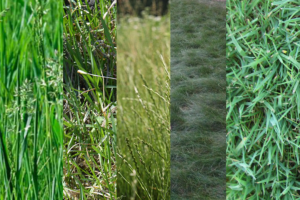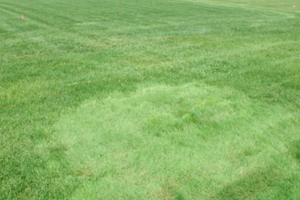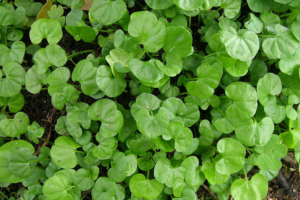
Tall Fescue, scientifically known as Festuca arundinacea, is a perennial grass species native to Europe. It has become a staple in many parts of the world due to its adaptability and resilience. Known for its deep roots and coarse texture, Tall Fescue is a popular choice for lawns, pastures, and athletic fields. Its ability to withstand various environmental conditions, including drought and heat, makes it versatile for various applications.
The species is unique in its ability to thrive in cool and warm seasons, making it a year-round grass in many regions. It’s also known for its high tolerance to foot traffic, making it an excellent choice for high-use areas. The grass’s deep green color and dense growth pattern also contribute to its popularity, providing an aesthetically pleasing landscape throughout the year.
Importance and Relevance of Tall Fescue in Various Fields
Tall Fescue plays a significant role in various fields, from agriculture to environmental conservation. In agriculture, it’s widely used as a forage grass due to its high yield and nutritional content, providing a reliable food source for livestock. Its deep root system also makes it an effective tool for soil conservation, helping to prevent erosion and maintain soil health.
Tall Fescue’s hardiness and aesthetic appeal make it a preferred choice in landscaping and sports turf management. It’s commonly found in home lawns, golf courses, and sports fields, where its resilience to wear and tear and ability to thrive in various climates are highly valued. Furthermore, its role in carbon sequestration and habitat provision underscores its ecological importance, contributing to biodiversity and mitigating climate change impacts.
In the following sections, we’ll delve deeper into the fascinating world of Tall Fescue, exploring its history, biological characteristics, cultivation techniques, and much more. Whether you’re a farmer, a landscaper, a homeowner, or simply someone interested in learning more about this remarkable grass species, there’s something in this comprehensive guide for you.
History and Origin of Tall Fescue
Discovery and Early Uses
Tall Fescue, known scientifically as Festuca arundinacea, is believed to have originated in Europe, with early records dating back to the Middle Ages. It was primarily found in meadows and pastures, valued for its hardiness and ability to provide forage for livestock. The grass’s resilience in various weather conditions and disease resistance made it a reliable feed source throughout the year.
The cultivation of Tall Fescue spread across Europe over the centuries, with farmers recognizing its value in sustaining their livestock. However, in the 19th century, Tall Fescue made its way to other parts of the world. European settlers introduced the grass to North America, quickly adapting to the diverse climates and becoming a staple in agricultural and residential landscapes.
Evolution and Spread Across the Globe
The widespread cultivation of Tall Fescue in the United States began in the early 20th century following the discovery of a particularly robust strain in Kentucky. This strain, aptly named ‘Kentucky 31’ or ‘K-31’, was noted for its exceptional tolerance to drought, heat, and poor soil conditions. The introduction of ‘K-31’ marked a significant turning point in the history of Tall Fescue, leading to its widespread use in pastures, lawns, and athletic fields across the country.
Today, Tall Fescue is found worldwide, from the temperate regions of North America and Europe to parts of Africa, Asia, and Australia. Its adaptability to various climates and soils and its utility in various applications has cemented its place as one of the most important grass species globally. As we learn more about this remarkable grass, its cultivation, and uses continue to evolve, underscoring the enduring relevance of Tall Fescue in our landscapes and ecosystems.
Biological Characteristics of Tall Fescue
Description and Physical Characteristics
Tall Fescue is a perennial grass species known for its robust and hardy nature. It typically grows between 2 to 4 feet tall, with deep roots that can extend several feet into the soil. This deep root system contributes to the grass’s exceptional drought tolerance, as it can access water from deeper soil layers. The leaves of Tall Fescue are coarse and dark green, with a distinct ridge running along the middle.
The grass is also characterized by its clump-forming growth habit, which results in a dense, uniform turf. The inflorescence, or flower, of Tall Fescue, is a panicle – a branched cluster of flowers that stands erect above the leaves. The seeds are small and enclosed in a hard shell, which aids in their dispersal and survival in various conditions.
Growth Cycle and Seasonal Behavior
Tall Fescue is a cool-season grass, which means it experiences its most vigorous growth during the more excellent parts of the year, typically in the spring and fall. During these periods, the grass is actively growing and will require more water and nutrients. In the summer, when temperatures rise, Tall Fescue enters a period of slowed growth and may go dormant in extreme heat.
Despite being a cool-season grass, Tall Fescue is known for its exceptional heat tolerance compared to other grasses in its category. This is mainly due to its deep root system, which allows it to access water from more profound into the soil during drought. This characteristic and its resistance to various diseases and pests contribute to its reputation as a hardy and resilient grass species.
Genetic Diversity and Types of Tall Fescue
Tall Fescue exhibits a high degree of genetic diversity, with numerous cultivars and varieties available today. These range from the traditional ‘Kentucky 31’ to newer turf-type and dwarf varieties. Each variety has been bred for improved drought tolerance, disease resistance, or aesthetic qualities.
Turf-type Tall Fescue varieties, for example, have been developed for their finer leaf texture and denser growth habit, making them an attractive choice for lawns and athletic fields. On the other hand, forage-type varieties are bred for their high yield and nutritional content, making them ideal for pastures. This genetic diversity not only underscores the adaptability of Tall Fescue but also allows for its use in a wide range of applications.
Environmental Requirements for Tall Fescue
Soil Requirements
Tall Fescue is known for its adaptability to various soil conditions. It can thrive in various soil types, from sandy to clayey soils, as long as they are well-drained. The grass prefers slightly acidic to neutral pH levels, typically between 5.5 and 7.0. However, it can tolerate more acidic or alkaline soils, albeit with reduced vigor.
While Tall Fescue can survive in poor soils, it performs best in fertile soils rich in organic matter. Regularly applying a balanced fertilizer can help maintain soil fertility and promote healthy growth. Additionally, its deep root system gives Tall Fescue a more remarkable ability to access nutrients from deeper soil layers, contributing to its overall resilience.
Climate and Weather Conditions
Tall Fescue thrives in regions with mild summers and cool winters as cool-season grass. It experiences its most vigorous growth in the spring and fall when temperatures are moderate. Despite this, Tall Fescue is noted for its exceptional heat tolerance compared to other cool-season grasses. This is mainly due to its deep root system, which allows it to access water from more profound into the soil during heat and drought.
Tall Fescue can also tolerate cold temperatures and is typically hardy in USDA zones 4 through 7. However, the grass may go dormant in regions with harsh winters but will usually recover once favorable conditions return. Its ability to withstand various weather conditions, from heat and drought to cold and frost, makes Tall Fescue a versatile choice for various climates.
Water and Sunlight Needs
Tall Fescue has moderate to high water needs compared to other grass species. While its deep root system allows it to survive periods of drought, regular watering is essential for maintaining a healthy and vibrant lawn. During periods of active growth, Tall Fescue typically requires about 1 to 1.5 inches of water per week, either from rainfall or irrigation.
In terms of sunlight, Tall Fescue prefers full sun but can tolerate partial shade. In areas with intense summer heat, some afternoon shade can even be beneficial in reducing stress on the grass. However, in heavily shaded areas, Tall Fescue may need help to grow and could become thin and patchy. As such, when planting Tall Fescue, it’s essential to consider its water and sunlight needs to ensure optimal growth.
Benefits of Tall Fescue
Ecological Benefits
Tall Fescue offers several ecological benefits contributing to its value in our landscapes and ecosystems. Its deep root system plays a crucial role in soil conservation, helping to prevent erosion by stabilizing the soil. This is particularly beneficial in areas prone to erosion, such as slopes and riverbanks. The roots also improve soil structure by creating channels that enhance water infiltration and reduce runoff.
In addition to soil conservation, Tall Fescue also contributes to carbon sequestration. Like all plants, it absorbs carbon dioxide from the atmosphere during photosynthesis and stores it in its biomass. This process helps mitigate the impacts of climate change by reducing the amount of carbon dioxide in the atmosphere. Furthermore, Tall Fescue provides a habitat for various fauna, contributing to biodiversity.
Agricultural Benefits
Tall Fescue is highly valued in the agricultural sector as a forage grass. It produces a high yield and maintains its nutritional quality throughout the year, providing a reliable food source for livestock. Its resilience to various diseases and pests and its ability to withstand heavy grazing makes it a preferred choice for pastures.
Tall Fescue’s deep root system also benefits agricultural lands by improving soil health. The roots enhance soil structure, promote water infiltration, and help cycle nutrients. This can improve soil fertility and productivity, benefiting other crops grown in rotation with Tall Fescue.
Aesthetic Benefits for Landscaping
Due to its aesthetic appeal, tall Fescue is a popular choice for lawns and landscapes. Its deep green color and dense growth habit create a lush and attractive turf. The grass is also known for its tolerance to foot traffic, making it an excellent choice for high-use areas such as athletic fields and parks.
In addition to its visual appeal, Tall Fescue’s hardiness and low maintenance requirements make it a practical choice for homeowners. It can withstand various environmental conditions, including heat, drought, and poor soils, reducing the need for intensive care. With proper management, Tall Fescue can provide a beautiful and resilient lawn that enhances the aesthetic value of any landscape.
Challenges and Problems with Tall Fescue
Common Diseases and Pests
Despite its hardiness, Tall Fescue is not immune to diseases and pests. Common diseases include brown patches, leaf spots, and rust. These diseases can cause discoloration, thinning, and reduced vigor in the grass. Fungicides and proper lawn care practices, such as avoiding overwatering and maintaining a balanced soil pH, can help manage these diseases.
Pests can also pose a problem for Tall Fescue. Armyworms, sod webworms, and cutworms are among the insects that can damage Tall Fescue lawns. These pests feed on the grass, causing brown patches and potentially significant damage if left unchecked. Regular monitoring and appropriate pest control measures can help keep these pests at bay.
Environmental Impact
While Tall Fescue has many benefits, it can also have negative environmental impacts. Tall Fescue is considered invasive in some regions and can outcompete native plants, reducing biodiversity. This is mainly a concern in natural areas where the introduction of Tall Fescue can disrupt local ecosystems.
Additionally, some varieties of Tall Fescue, particularly those used for forage, are hosts to a fungal endophyte. While this endophyte can enhance the grass’s stress tolerance and resistance to pests, it can also produce toxic alkaloids in some animals. This can pose a challenge in managing Tall Fescue pastures for livestock.
Management Difficulties
Tall Fescue requires careful management to maintain its health and appearance. It has a clumping growth habit, leading to a patchy appearance if not properly managed. Regular mowing and overseeding can help maintain a dense and uniform lawn.
Furthermore, while Tall Fescue is drought-tolerant, it can still suffer from heat stress during extreme temperatures. During these periods, the grass may go dormant and turn brown. However, with proper watering and care, it can recover once excellent conditions return. Understanding and managing these challenges is critical to successfully growing and maintaining Tall Fescue.
Cultivation and Management of Tall Fescue
Planting and Seeding Techniques
Planting Tall Fescue can be done through seeding, sodding, or sprigging, with seeding being the most common method due to its cost-effectiveness. The best time to plant Tall Fescue is in early fall when temperatures are moderate, and the grass has enough time to establish before winter. The seeds should be spread evenly over the surface and lightly covered with soil to ensure good seed-to-soil contact.
Before planting, it’s essential to prepare the soil by removing any existing vegetation and loosening the top layer of soil. Adding a starter fertilizer when planting can also help promote early growth. Once planted, the area should be watered regularly until the grass is well established.
Fertilization and Irrigation Practices
Tall Fescue benefits from regular fertilization to maintain its health and color. A balanced fertilizer that contains nitrogen, phosphorus, and potassium is typically recommended. Most fertilizer should be applied in the fall and spring when the grass is actively growing, with lighter applications in the summer.
When it comes to watering, Tall Fescue requires about 1 to 1.5 inches of water per week during active growth periods. It’s best to water deeply and infrequently to encourage profound root growth. Additional watering may be necessary in extreme heat or drought to prevent the grass from dormant.
Mowing and Maintenance Tips
Proper mowing is crucial for maintaining a healthy and attractive Tall Fescue lawn. The recommended mowing height for Tall Fescue is between 2.5 to 3.5 inches. Keeping the grass at this height can help promote dense turf and reduce weed competition. It’s also important to keep mower blades sharp to ensure clean cuts and reduce stress on the grass.
In addition to mowing, regular overseeding can help maintain a dense and vibrant lawn. This is particularly important for Tall Fescue due to its clumping growth habit, leading to thin or patchy areas over time. Overseeding should be done in the fall, coinciding with the grass’s peak growth period. Tall Fescue can provide a resilient and attractive lawn for many years with proper cultivation and management practices.
Uses of Tall Fescue
Use in Lawns and Sports Fields
Tall Fescue is a popular lawn choice due to its deep green color, dense growth habit, and resilience to foot traffic. Its ability to withstand various environmental conditions, including heat, drought, and poor soils, makes it a practical choice for homeowners. With proper care, Tall Fescue can provide a lush and attractive lawn that enhances the aesthetic value of any landscape.
The grass is also commonly used in sports fields and golf courses due to its durability and tolerance to wear and tear. Its deep root system allows it to recover quickly from damage, making it an excellent choice for high-use areas. Furthermore, its ability to grow in cool and warm seasons ensures a green and vibrant field throughout the year.
Use in Pasture and Forage
Tall Fescue is widely used as a forage grass in the agricultural sector. It produces a high yield and maintains its nutritional quality throughout the year, providing a reliable food source for livestock. Its resilience to various diseases and pests and its ability to withstand heavy grazing makes it a preferred choice for pastures.
Tall Fescue’s deep root system also benefits agricultural lands by improving soil health. The roots enhance soil structure, promote water infiltration, and help cycle nutrients. This can improve soil fertility and productivity, benefiting other crops grown in rotation with Tall Fescue.
Use in Erosion Control and Soil Conservation
Tall Fescue’s deep root system plays a crucial role in soil conservation. The roots help stabilize the soil, preventing erosion by wind and water. This makes Tall Fescue an effective tool for erosion control in areas prone to soil degradation, such as slopes and riverbanks.
In addition to preventing erosion, the roots of Tall Fescue also improve soil structure and fertility. They create channels in the soil that enhance water infiltration and reduce runoff. They also help cycle nutrients in the soil, contributing to soil health and productivity. As such, Tall Fescue is often used in soil conservation projects and land reclamation efforts.
Case Studies
Case Study 1: Missouri’s Experience with Tall Fescue
The University of Missouri Extension has published a comprehensive guide on Tall Fescue, which includes several case studies on its use in pastures. The guide discusses the challenges and benefits of using Tall Fescue in pastures, including its ability to provide year-round forage for livestock and its resilience to various environmental conditions. However, it also highlights the importance of proper management to mitigate the potential negative impacts of endophyte-infected Tall Fescue on livestock health. Read more here
Case Study 2: Novel Endophyte-Infected Tall Fescue in Georgia
The University of Georgia Extension has extensively researched novel endophyte-infected Tall Fescue. These novel endophytes provide many of the benefits of traditional endophytes, such as improved stress tolerance and pest resistance, without producing the toxic alkaloids that can harm livestock. The research highlights the potential of these novel endophytes in improving the safety and productivity of Tall Fescue pastures. Read more here
Case Study 3: Tall Fescue in Erosion Control and Soil Health
A study published in the National Center for Biotechnology Information explored the role of Tall Fescue in erosion control and soil health. The study found that Tall Fescue’s deep root system helped stabilize the soil and reduce erosion. Additionally, the roots improved soil structure and fertility, contributing to overall soil health. These findings underscore the value of Tall Fescue in soil conservation and land reclamation efforts. Read more here
Case Study 4: The Impact of Tall Fescue on Michigan’s Landscapes
Michigan State University Extension discusses the impact of Tall Fescue on Michigan’s landscapes. The article highlights the grass’s adaptability to various soil and weather conditions, making it a popular choice for lawns and sports fields in the state. However, it also discusses the challenges of managing Tall Fescue, including its potential to become invasive and outcompete native plants. Read more here
Case Study 5: The Role of Tall Fescue in Carbon Sequestration
A study published in ScienceDirect explored the role of Tall Fescue in carbon sequestration. Like other grass species, the study found that Tall Fescue significantly mitigates climate change by absorbing carbon dioxide from the atmosphere and storing it in its biomass. This research highlights the ecological importance of Tall Fescue and its potential role in climate change mitigation strategies. Read more here
4″>
Future of Tall Fescue
Advancements in Breeding and Cultivation
The future of Tall Fescue looks promising, with ongoing advancements in breeding and cultivation techniques. Breeders continually develop new varieties of Tall Fescue that exhibit improved traits, such as increased drought tolerance, disease resistance, and aesthetic qualities. For example, turf-type Tall Fescue varieties are bred for their finer leaf texture and denser growth habit, making them an increasingly attractive choice for lawns and athletic fields.
In addition to breeding for improved traits, there’s also a growing interest in developing varieties of Tall Fescue that are more environmentally friendly. This includes varieties that require less water and fertilizer and are more beneficial to wildlife. These advancements in breeding and cultivation are expected to expand the use of Tall Fescue in both agricultural and residential settings.
Role in Climate Change Mitigation and Soil Conservation
As concerns about climate change and soil degradation continue to grow, the role of Tall Fescue in mitigating these issues is likely to become increasingly important. Tall Fescue’s ability to sequester carbon and improve soil health is valuable in climate change mitigation and conservation efforts.
Research is ongoing to understand further and maximize these benefits. For example, studies are being conducted to quantify the amount of carbon that Tall Fescue can sequester and to identify management practices that can enhance this ability. Similarly, research is being done to explore how Tall Fescue can improve soil health in different contexts, from agricultural lands to urban landscapes.
Tall Fescue offers hope in the face of these environmental challenges. Its resilience, versatility, and ecological benefits position it as a key player in our landscapes and ecosystems, now and in the future.
Conclusion
Recap of Tall Fescue’s Significance
Tall Fescue, with its rich history, diverse applications, and remarkable resilience, stands as a testament to the adaptability and utility of grass species. From its origins in Europe to its global presence today, Tall Fescue has proven its worth in various fields, from agriculture and landscaping to soil conservation and climate change mitigation.
Its deep root system, tolerance to various environmental conditions, and high nutritional value make it a valuable resource for farmers, homeowners, and environmentalists. However, as with any plant species, it comes with challenges, including susceptibility to certain diseases and pests, potential invasiveness, and management difficulties.
Looking Forward
As we move forward, the future of Tall Fescue looks promising. Ongoing advancements in breeding and cultivation techniques are expected to yield new varieties with improved traits, expanding its use in various settings. Moreover, its role in climate change mitigation and soil conservation will likely become increasingly important in the face of growing environmental concerns.
The journey of understanding and utilizing Tall Fescue is far from over. As we explore its potential and address its challenges, Tall Fescue will remain a significant player in our landscapes and ecosystems. Whether you’re a homeowner seeking to cultivate a lush lawn, a farmer managing pastures, or an environmentalist working on soil conservation, Tall Fescue offers a world of possibilities to explore and benefit from.
References
1. Oregon State University
Oregon State University provides a comprehensive monograph on Tall Fescue, covering its history, biology, cultivation, and uses. The monograph also includes a detailed list of references for further reading. Read more here
2. BeaverTurf
BeaverTurf, a resource provided by Oregon State University, offers a wealth of information on Tall Fescue, including its characteristics, cultivation practices, and management challenges. The site also provides links to additional resources and research on Tall Fescue. Read more here
3. USDA Plant Guide
The USDA Plant Guide provides a detailed overview of Tall Fescue, including its description, distribution, uses, and management. The guide also includes references to the scientific literature on Tall Fescue. Read more here
4. Cornell University Weed Identification
Cornell University provides a detailed profile of Tall Fescue, including its identification, biology, and management. The profile also includes references to additional resources on Tall Fescue. Read more here
5. Invasive.org
Invasive.org provides a fact sheet on Tall Fescue, discussing its characteristics, distribution, and potential impacts as an invasive species. The fact sheet also includes references to additional resources on Tall Fescue. Read more here

Bob Green, a passionate lawn care enthusiast with over two decades of landscaping experience, is this website’s proud owner. His vast knowledge of horticulture and dedication to helping homeowners maintain beautiful lawns are reflected in the valuable content he shares on his platform. John has always been interested in Agrostology.














